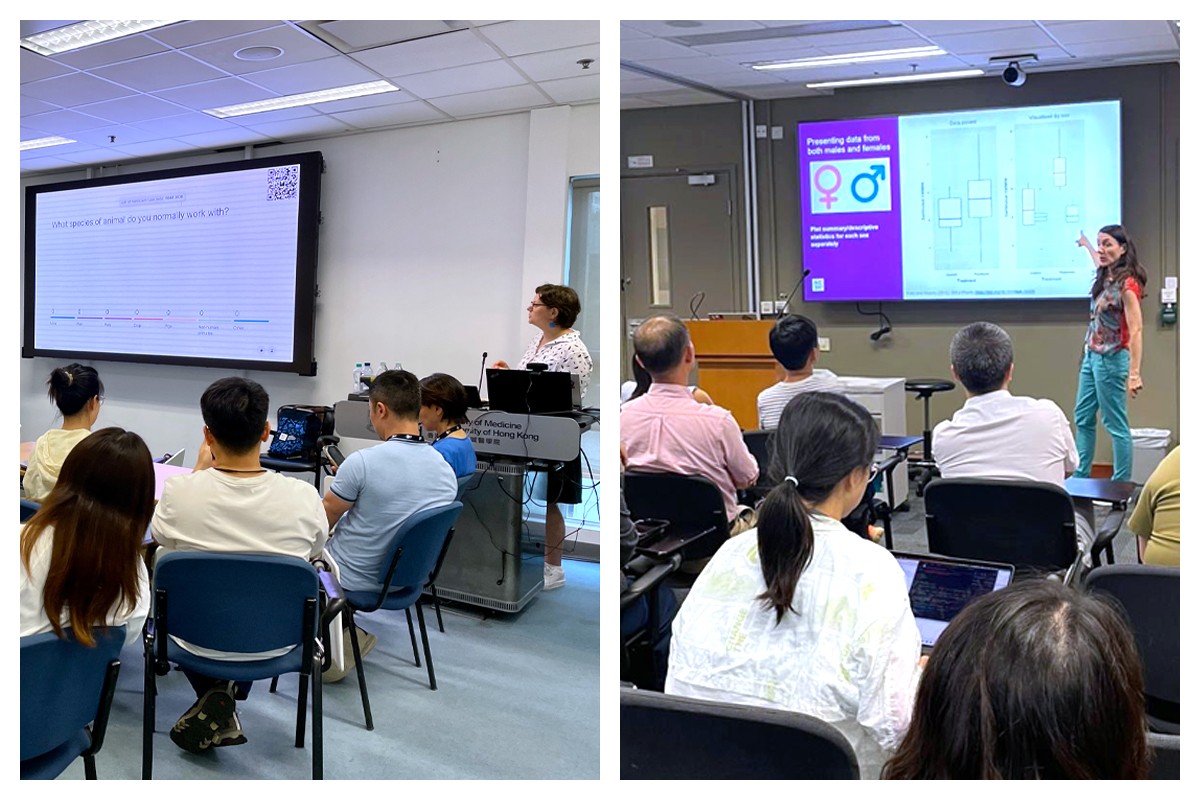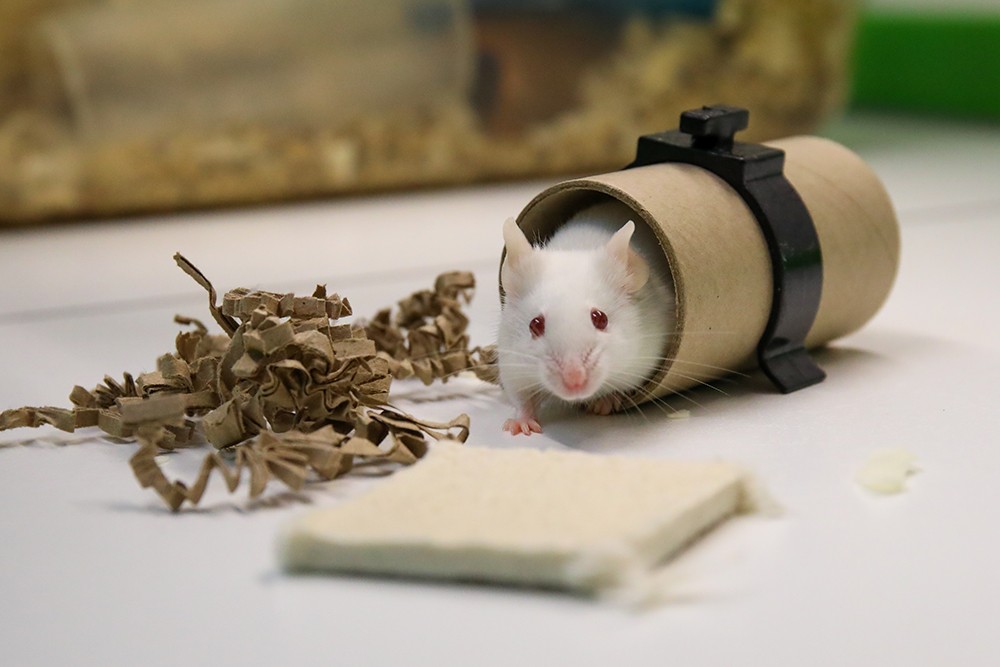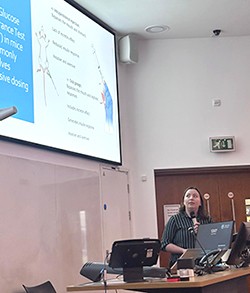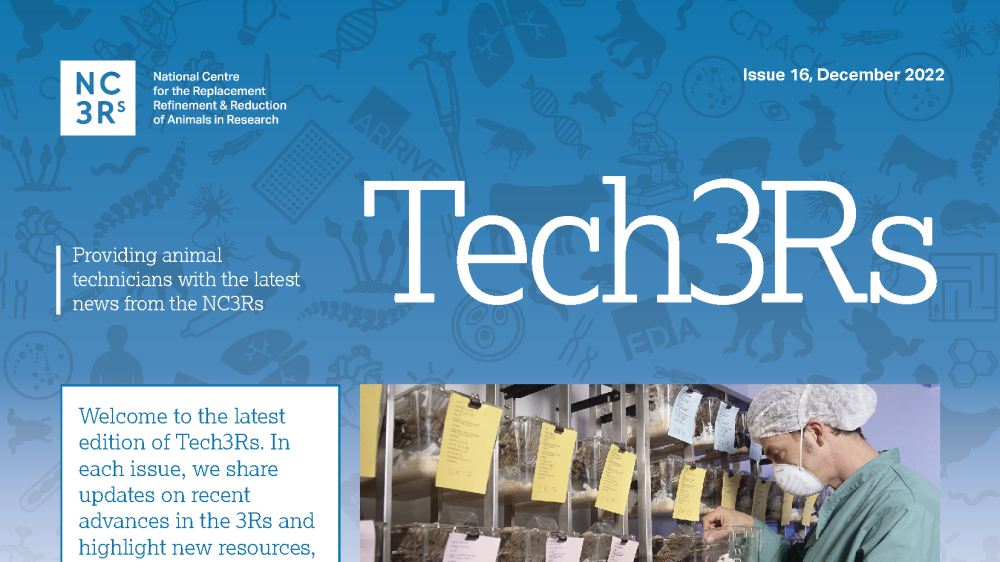Tech3Rs: Issue 21 (November 2025)
In this issue we share the importance of animal technicians in helping to produce reliable results and speak to Katherine Pye about how her experiences gained as a research technician at the University of Exeter helped to shape her career journey. We hear from two Tech3Rs champions about how they reduced aggression in male CD-1 mice by evaluating different combinations of environmental enrichment and highlight 3Rs papers showcasing simple approaches to increase environmental complexity for improved welfare across different species.
In this edition
The role of animal technicians in producing reliable results
When animals are used in research, ensuring the highest possible quality of data is a shared responsibility across the entire research team. Technical staff play a vital role in this process. From the moment animals are unboxed and transferred to their home-cages, through to the point of testing and data collection, every stage presents an opportunity to improve the reliability of scientific outcomes. This includes maintaining high standards of animal welfare to minimise the risk of stress as an unintended variable and understanding what bias is and how to reduce its impact. Bias occurs when something unintentionally influences the outcome of an experiment favouring one outcome or answer over others. It is almost always unintentional and even the most experienced researcher can introduce bias into a study.
In June, Drs Nathalie Percie du Sert and Esther Pearl were invited to share NC3Rs resources at the Hong Kong Laboratory Animal Sciences Society symposium. They also delivered workshops on practical approaches to reducing bias in animal experiments. The sessions included hands-on activities on ways to randomise animals or home-cages/tanks under different experimental circumstances. Nathalie and Esther led group problem-solving activities based on real experimental situations to consider how masking, also known as blinding, can be put into practice to reduce bias.

Randomisation, masking and other ways to minimise the influence of bias are outlined in our resource on improving the scientific quality of your enrichment study. The guidance is focused on technician-led welfare studies, but it is a useful tool for anyone looking to understand bias and how to minimise its impact. It includes real examples of potential sources of bias and simple steps to improve data reliability.
It was great to share our resources and expertise with over 70 animal facility staff in Hong Kong and see how technicians are working to advance the 3Rs across the globe. We usually run our workshops closer to home – to enquire about in-person training, get in touch with our Training and Engagement team.
Tech3Rs champions: Amy Veness and Christophe Galichet

Amy Veness, Animal Technician, and Christophe Galichet, Research Operations Manager and Named Training and Competency Officer, from the Sainsbury Wellcome Centre at University College London, share how they reduced aggression in male CD-1 mice by evaluating different combinations of environmental enrichment.
What 3Rs idea have you implemented at the Sainsbury Wellcome Centre?
We worked with CD-1 male mice that needed to be group housed to study social behaviours and their underlying neural circuits. In accordance with the NC3Rs laboratory mouse aggression study, we were seeing a high prevalence of aggression within our CD-1 colony. We have now reduced the number of aggression-related injuries by taking an evidence-based approach to the environmental enrichment that we provide to our CD-1 mice.
Originally, our mice were housed with a plastic tunnel, an igloo shelter which had an attached running wheel (igloo-wheel) and Aspen block, but we hadn’t done any formal evaluation to assess whether this combination of enrichment was improving welfare. To investigate whether different types of enrichment could help reduce aggression, we trialled two other enrichment combinations and compared the number of fight wounds recorded during routine husbandry to data obtained with our standard enrichment. We found that adding materials that can be pulled apart and made into nests, like sizzle nest and nestlets, alongside an igloo-wheel or cardboard tunnels reduced fighting between our male CD-1 mice. This was backed up by the data we collected – when housed with an igloo-wheel and plastic tunnel 24% of mice reportedly suffered fight wounds, compared to only 1.9% when housed with sizzle nest, nestlets, an igloo-wheel and a cardboard tunnel, and 1.9% when the igloo-tunnel was replaced with a further two cardboard tunnels.
How did you develop this project?
The idea came about when one of our project licence holders approached us with their concern that they were having to frequently split groups of male CD-1 mice due to fighting. Group housing was required as they were investigating social behaviour, so in addition to the welfare impact of fighting, this meant that a lot of mice were being removed from their study. They also told us that they had not encountered this issue when they had previously worked with this strain and suggested that using different enrichment could be a solution. We decided to work together to carry out an evaluation of environmental enrichment, an approach that is recommended within the NC3Rs resource on minimising aggression in group-housed male mice.
You will go to different units and everyone will have the same stories, it is just no one has actually put pen to paper.
We started by doing research online, planning an approach to incorporate the health data we already had with data we were collecting during routine husbandry – a strategy outlined in the planning section of the NC3Rs evaluating environmental enrichment resource. When it came to selecting different enrichments to trial, we considered what the researcher told us they had used elsewhere and what was available from our suppliers. We also used our network to develop ideas whilst speaking to people at conferences. We decided to try different combinations of igloo-wheels, plastic tunnels, carboard tunnels, nestlets and sizzle nest in their home-cages to see if this impacted the level of aggression observed.
Amy collected the data from our animal database and shared this with Christophe, who did further analysis of the data and saw the potential for a publication. We were really supported by our team along the way. Eleni Amaniti, our Head of Facility, and the centre’s Executive Team, all encouraged us to pursue this work.
Tell us about the impact of the project?
Based on our findings, we implemented changes across the centre to how we house male CD-1 mice which benefited over 1,000 mice during the course of the project. We also now evaluate the enrichment we provide for different strains and sub-strains of mice, instead of assuming that the standard enrichment is a one-size-fits-all solution. It has been really rewarding to see how our work has made a positive impact to the lives and welfare of our mice. Before publishing our paper, we also had the chance to share our findings at conferences and other institutes. Amy presented the work at The Institute of Animal Technology (IAT) Congress 2023 where we got lots of interest. This led to being invited to present our work at the Francis Crick Institute and the Laboratory Animal Science Association (LASA) conference 2023 in Cambridge.
The mice were a lot calmer with each other.
Following the success of this project, we are motivated to keep finding ways to improve the lives of the animals we care for. Our advice for anyone who wants to make impactful change to the lives of their animals is collaboration – this work was a true joint effort between technical and research staff and team members of the SWC Neurobiological Research Facility at all levels – the head of the facility, the group leader and the executive team. A researcher recognised a specific concern in their study and turned to the animal technician for help finding a solution that improved both the welfare of the animals and the robustness of the scientific output.
If you want to make informed decisions about the suitability of environmental enrichment items for animals within your facility the first step is a solid plan.
For questions to consider before you begin a study and to download a project planning sheet, visit our guidance on planning an enrichment evaluation.
If you are aiming to address a welfare issue, such as aggression, you can adapt any of our step-by-step example enrichment study protocols.
Read our recommendations for reducing aggression between group-housed male mice for advice on how to implement the findings from our laboratory mouse aggression study.
Veness A et al. (2025). A customised combination of environmental enrichment reduces aggression in CD-1 male mice. Laboratory Animals 0(0): 1–5. doi: 10.1177/00236772251333986.
Tech journeys: Katherine Pye
Featuring technicians with career paths built on their long-term commitment to the 3Rs. If you have an inspirational story, or know someone else who does, email us at tech3Rs@nc3rs.org.uk.
Katherine Pye shares how the opportunities and experiences that she gained as a research technician at the University of Exeter, including work on an NC3Rs-funded refinement project, helped to shape her career journey.

glucose tolerance test at an NC3Rs
symposium.
I have always loved working with animals. Early on, I thought veterinary science would be the perfect way to combine this passion with my interest in science. While that path never quite worked out for me, it instead led me to focus on fundamental science, studying biochemistry and genetics and graduating with a masters. In 2019, I joined the University of Exeter as a research technician, where I worked with both mice and rats. I was largely responsible for assisting the work of others through the handling and restraint of animals undergoing procedures, as well as tissue collection and genotyping. I actively sought out ways to support ongoing projects by learning new techniques, which enabled me to build a broad and diverse training record in rodent work. This includes substance administration and surgical procedures such as stereotaxic brain surgery and monitoring and managing anaesthesia during cardiovascular surgery in rats. I think my love of animals has definitely been beneficial for working with animals in science. I can recognise the need for robust and reproducible animal work for furthering our understanding of disease, and I am eager to give the animals the best possible welfare wherever possible.
Developing my role, gaining responsibility and driving refinement
During my time as a technician, I worked closely with Professor Kate Ellacott, who has been a great mentor to me. It was through an NC3Rs award to Kate in 2022 that I became involved in a project to refine how mice are dosed during the glucose tolerance test (GTT), building on work by Dr Tina Notter (University of Zurich). The glucose tolerance test is used in both clinical settings with human patients and in animal studies to investigate and develop treatments for metabolic diseases, such as diabetes. During the test, human patients voluntarily drink a sugary solution but mice are typically dosed with glucose via intraperitoneal injection or oral gavage.
The NC3Rs-funded project focused on adapting and validating the micropipette-guided drug administration (MDA) oral dosing technique to replace dosing by oral gavage and, in some cases, intraperitoneal injection in mice. Using this non-invasive method, mice voluntarily drink the glucose solution with minimal restraint. The glucose tolerance test is used in metabolic research worldwide and mice are the most used species, so refining how they are dosed will benefit a large number of mice globally. This project has been a driving force behind my career development, as this was the first time that I had a significant role in spearheading the direction of a project. I was passionate about the development of this refinement, and that led to more responsibility within the project. I am now a Graduate Research Assistant with the University of Exeter running my own studies and carrying out all procedures with a focus on glucose metabolism assays.
I applied for funding to continue my work promoting the uptake of the micropipette-guided drug administration oral dosing technique and in 2025 I was awarded an NC3Rs early career engagement award. This funding has enabled me to travel to two universities in New Zealand, where prominent metabolic research in mice takes place. I shared the method used to habituate mice to the refined dosing technique with teams of academic researchers and animal technicians, allowing them to apply the approach to their own studies. The grant has also enabled me to present the method at the University of Cambridge, from which further engagement, networking and dissemination opportunities have arisen.
Better welfare, better science
Understanding how a refined procedure compares to current approaches, and how the new approach can improve the quality of the research, is very important when you are trying to get others to adopt a refinement. The body’s response to glucose begins when it is sensed in the mouth, so allowing mice to drink the solution is more translationally relevant than delivering the glucose by injection or directly to the stomach. This means that micropipette-guided drug administration can be a better scientific approach for research into metabolic disorders because it is more representative of what occurs in human patients. If you are an animal technician seeking 3Rs opportunities, one approach is to chat to your research colleagues about the specific scientific needs of their studies. These conversations can highlight where current refinements may need to be adapted to align with research goals and how you could work together towards the mutual goal of better welfare and better science.
We validated our oral dosing refinement against traditional gavage-dosing in mice and found that it takes the same time for blood sugar levels to return to normal – so the techniques are comparable in terms of glucose clearance. However, mice dosed using the refined approach had significantly lower levels of the stress hormone corticosterone. Stress hormones are a source of variation in nearly all in vivo studies and it is important to minimise stressors where we can. For this reason, we also used refined methods to pick up the mice (a tunnel or cupped hands) during husbandry and habituation for dosing. Habituating the mice to the refined dosing technique requires up to one week of additional habituation time, but this is typically less than two minutes per animal per day. Addressing potential barriers to adoption is another important aspect to encourage uptake of refinements, so I was sure to address the additional habituation time in my validation of the protocol. To quote directly from my paper, “an increase in researcher time should not be seen as a block but rather part of the normal process for securing the highest quality data and welfare standards”.
Building confidence and championing change across my career

NC3Rs symposium.
I have been lucky where I landed at the University of Exeter, being involved in interesting projects that have expanded my experience of working with animals in the scientific setting. I would encourage anyone who is not sure about where to go next in their career to be open to learning new things and to get involved in different aspects of projects to see what sparks interest. My career has developed in this way largely because I have said yes to all the opportunities that have come my way. My proactive approach to seeking new ways to further my development, such as applying for the NC3Rs early career engagement award, has also been a major contributor to the direction that my career journey has taken. Upon reflection, it has been the opportunities that I was most nervous about that have been the most beneficial to my personal development – particularly the public speaking!
I have now presented at numerous symposia, conferences and other events across the world and I can see that my work is starting to make a difference in the way glucose tolerance tests are planned and carried out. I will continue to develop the micropipette-guided drug administration oral dosing technique for glucose tolerance tests. I am currently looking at how long mice retain their habituation memory for long-term experiments. I am also investigating if the overall handling time for the habituation period can be reduced because, in my experience, this is a main barrier to adoption. When I started my role as a technician in 2019, I never thought that I would be presenting my research both locally and internationally, organising my own projects, or having the knowledge needed to champion a methodological and welfare refinement with the understanding of barriers to its adoption and how they might be overcome. I am now intending to use the micropipette-guided drug administration methods as a basis for a PhD – a goal that I had not previously considered. My desire to pursue a PhD has grown alongside my experience and confidence in my ability as a scientist.
Explore the Rodent MDA website for resources on refining oral treatments in laboratory rodents.
Pye K et al. (2024). bioRxiv. 2024.09.13.612859. [version 1; preprint].
doi: 10.1101/2024.09.13.612859.
3Rs papers of interest
Summaries of recent 3Rs papers, including key techniques and approaches, findings and 3Rs impacts.
In this issue we look at ways to reduce the welfare impact of standard laboratory housing conditions on zebrafish, rats and rabbits using simple approaches to increasing environmental complexity.
Rearing in a physically enriched environment affects shoaling and stress responses of zebrafish (Danio rerio) exposed to novel conditions
- This study investigated if a simple enrichment device, a three-way PVC pipe, could reduce stress and anxiety-like behaviours in zebrafish (AB line wildtype, four months old).
- 80 adult zebrafish were randomly assigned to either a control tank (image of pebbles but no physical enrichment) or an enriched tank (image of pebbles and PVC pipe).
- Fish were maintained in mixed sex groups of ten under their usual husbandry conditions for 90 days, before being transferred to a novel tank for a shoaling test to assess behavioural responses associated with anxiety.
- Water samples were taken from the home-tank before and after the fish were moved for testing. These samples were used to measure cortisol levels to assess the stress response.
- The fish in enriched tanks maintained greater distances from one another and spent more time without physical contact, indicating reduced anxiety. Only the control fish showed a significant increase in cortisol after the shoaling test.
- These findings suggest that even simple enrichment can reduce stress responses and improve zebrafish welfare.
The development and use of a cage-topper to enhance rat welfare
- This Tech-2-Tech paper shares the design of a ‘cage topper’ that stacks on top of standard rat cages to increase vertical space.
- The cage toppers were built in-house for £55 each and the utility and impact on rat welfare was assessed by technical staff, the Named Veterinary Surgeon (NVS) and researchers.
- Technicians observed that the rats used the extra space to stretch, climb and play as well as an alternative location to sleep.
- The technicians identified that improvements could be made to make the corners of the topper easier to clean and the NVS shared their concerns about biosecurity.
- The NVS noted no increase in injuries or aggression, despite rats sometimes falling from the top of the cage during play.
- Researchers used the toppers in five studies with 120 rats. They concluded that cage toppers could be used both to improve and study rat welfare and that its temporary removal could be used as an experimental manipulation to induce more negative welfare states in Lister-hooded rats.
- The team concluded that cage toppers were a cost-effective way to improve the welfare of rats by providing more space and environmental complexity than standard caging.
- However, they identified that formal assessment of animal health and biosecurity was necessary, flagging that the toppers should not be used for rats that are in poor health, immunocompromised or specific-pathogen-free.
Behavioral effects of floor pens as environmental enrichment for laboratory rabbits (Oryctolagus cuniculus)
- This study investigated the welfare benefits of using floor pens as environmental enrichment for laboratory rabbits at a Brazilian animal facility.
- Over two months, individually-housed male New Zealand White rabbits were given weekly 40-minute sessions in floor pens (120 x 180 cm) covered in wood shavings and containing cotton pieces, a plastic shelter, buckets, cardboard tubes and plastic pipes.
- Behaviour was recorded in the home-cages at the start and end of the two-month period to see if the floor pen access improved welfare.
- Using an ethogram, behaviours were categorised into six types: inactive, physiological, neutral, maintenance, positive and negative behaviours.
- Home-cage behavioural recordings lasted 60 seconds and were taken six times a day, three days a week. Behaviour in the floor pens was recorded every ten minutes for 60 seconds during each 40-minute session.
- After two months of weekly access to floor pens, the rabbits showed an increase in time spent inactive (i.e. resting) in the home-cage (from 31% to 55%) and a reduction in negative behaviours, including stereotypies (from 13.5% to under 5%).
- During the floor pen sessions, rabbits spent over half their time engaging in positive behaviours such as exploration and interaction with the enrichment.
- The authors concluded that regular access to enriched floor pens (also known as ‘playpens’), even for short periods of time, can enhance welfare by allowing rabbits to explore and exercise in a larger and more complex environment.
- A limitation acknowledged by the authors is that the study used males only, so it is unclear whether the same benefits would apply to females. Additionally, the findings may not apply to rabbits housed with access to enrichment within the home-cage, such as UK facilities where playpens are used to supplement rather than substitute within-cage enrichment.
Our evaluating environmental enrichment resource includes:
- Guidance on how to use ethograms to evaluate environmental enrichment and downloadable ethograms for laboratory zebrafish, rodents and rabbits.
- Easy-to-implement steps to help you maximise the quality of the data you collect.
- Example enrichment evaluation protocols, which can be tailored to suit your own studies.
We also have advice on setting up a playpen in your facility, focusing on playpens for rats, but can be applied across species. Read our news story for research demonstrating the positive welfare benefits of playpens for rats.
Updates and events
Free training on zebrafish skin swabbing for refined DNA sampling
Skin swabbing is a refined DNA sampling method that offers an alternative to fin clipping. The NC3Rs is supporting Will Norton and Ceinwen Tilley from the University of Leicester to deliver training workshops at UK facilities to help groups take up the refined approach for genotyping zebrafish.
The session can be tailored to your current protocol and research and will include practical guidance and troubleshooting topics alongside support to adapt the technique to your laboratory or facility. Delivered at your facility, the session accommodates up to ten participants to ensure personalised, one-on-one support. Remote support is also available after the session for further troubleshooting and follow-up questions.
Register your interest in a zebrafish skin swabbing workshop at your institution by Friday 14 November 2025.
You can also learn more about skin swabbing and why it is an important refinement for zebrafish, including FAQs, a skin swabbing protocol and instructional video.
The Animal Welfare Institute’s Refinement Database
Searching published literature is the best way to find evidence-based approaches to improve animal welfare. It is also an important first step if you are planning to implement or evaluate a refinement, including when you seek to gain support for your approach from management or your research colleagues. The Refinement Database, launched by the Animal Welfare Institute in 2000 and remodelled in 2025, is a regularly updated collection of scientific publications focused on improving the care and use of animals in research that makes searching by animal type and topic easy. The categories cover all aspects of housing, handling, husbandry and procedures, including environmental enrichment, animal training and substance administration. These topics can be filtered by species to help you find the information that is most relevant to the animals that you care for.
"Animal care technicians are essential to protecting the welfare of animals in laboratories, as it’s their job to ensure safe and comfortable living quarters, appropriate stimulation, and gentle and cooperative handling. Our Refinement Database provides a centralised resource so caretakers can quickly locate the refinement information they seek, without having to parse through pages of unrelated search results."
Dr Maisy Englund, Animal Cognition Scientist at the
Animal Welfare Institute.
Online workshop: Understanding and improving laboratory animal welfare
8 – 10 December 2025, online
This online workshop delivered by the Research Animal Training (RAT) platform is aimed at animal technicians, veterinarians, research staff and facility managers seeking to improve welfare and implement refinements in their current protocols for laboratory rodents and rabbits.
The programme combines pre-recorded webinars, e-learning modules and live sessions with Q&A and interactive exercises. Key topics cover concepts of stress and distress, severity assessment, humane endpoints and positive welfare.
Register for the RAT online workshop.
NC3Rs welfare webinar series

Two upcoming welfare webinars will cover topics on positive reinforcement and habituation of pigs, dogs and primates.
Register now: Socialisation and positive reinforcement training for pigs and dogs.
- 27 November, 12.30 – 13.30 (GMT).
- Speaker: Cathrine Juel Bundgaard, Novo Nordisk.
Registration opening soon: Habituation of minipigs, primates and dogs for procedures in toxicology studies.
- 29 January, 12.30 – 13.30 (GMT).
- Speaker: Manuela Teti, Labcorp.
Webinar recordings and Q&As now available
Improving the lives of laboratory zebrafish
Professor Robert Gerlai joined us to discuss an ethological approach to zebrafish care, grounded in their natural behaviour and ecology. The recording is accompanied by a written Q&A document where Robert expands on key points and answers questions such as “What approaches could I take back to my facility to start improving zebrafish welfare today?”
Refined humane endpoints and early interventions
Cross-sector speakers joined us to explore how refined, study-specific humane endpoints and early intervention strategies can be implemented in different research scenarios to minimise animal suffering.
Find out more about the welfare webinar series, register for upcoming events and watch recordings of previous sessions.
Get an email notification as soon as the next issue of Tech3Rs is available to download. We recommend that this is then circulated to colleagues or printed out for display in animal houses.

